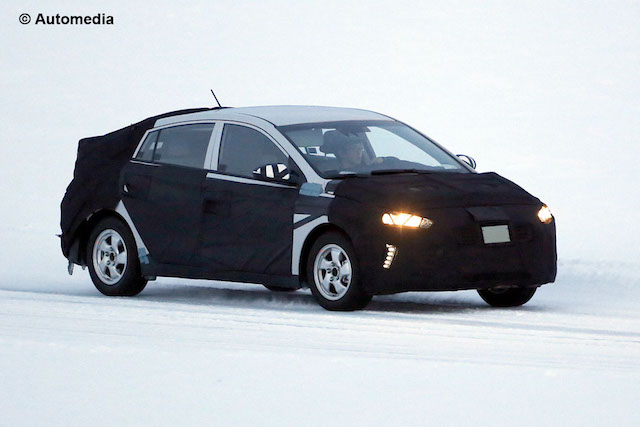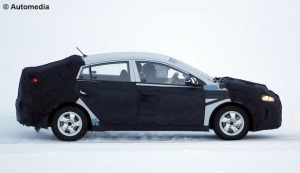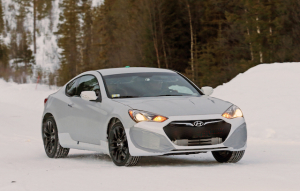
Hyundai talked up the eco-friendliness at last month’s Detroit motor show of its plug-in Sonata hybrid sedan – but it hasn’t and isn’t talking about its new rival for the Toyota Prius.

Nor is it saying anything about the next-generation Genesis coupe. Both the two-door Genesis and the Prius challenger are pictured here testing in the snow in Europe, one wearing aprons and skirts to hide its true self from spy photographers, the other a cut-and-pasted body of the current coupe hiding an optional all-wheel-drive system and showing a new bulge in the bonnet to hold the 5.0-litre V8 engine from the premium Genesis sedan.
Don’t expect the finished Genesis coupe No. 2 to look anything like the current two-door – if anything it will be more in line with the styling of the Hyundai HNF9 prototype shown at the 2013 Seoul motor show.
The sedan and the coupe have both been available as left-hookers since the first generation Genesis in 2008. But it’s only since last year that the second-generation Genesis sedan made it into the right-hand-drive world.
It has just arrived in New Zealand, powered by a 232kW/397Nm 3.8-litre V6 engine mated to an eight-speed automatic gearbox and priced at $99,900.
I was the first NZ journalist to drive the four-door Genesis, back in 2008 on South Korean island Jeju, a popular tourist spot off the southern tip of the country. A World Heritage site, it’s about 100 square kilometres bigger than Stewart Island. (Stewart Island has a permanent population of around 400; Jeju has upwards of 650,000).

The Genesis was an early production example, just before exports to the US of the first-generation model began. Then as now, the US-spec Genesis has also been available with a 3.3-litre V6 and 5.0-litre V8.
I was with then Hyundai NZ chief Phillip Eustace when Fairfax motoring editor Dave Moore rang my cellphone from his Christchurch base to ask what the car was like.
I remember telling him that Hyundai had done what carmakers do all the time: take apart bit by bit rival models to see what makes them tick, then try and improve on them.
Hyundai had learned a lot from Japan’s Lexus: the Genesis’ interior quality was Lexus-like and the car would only get better, I said. From memory, the Genesis was let down by its ride, good on Jeju’s smooth blacktop, but so-so on lumpier surfaces. It was a flaw then and, according to a recent Australian report, it’s still a niggling concern.

Meantime, Hyundai’s Prius rival is code-named the ‘AE HEV’ and believed to be based on the new-generation Elantra platform. ‘AE’ is the programme code for the car and HEV stands for ‘Hybrid Electric Vehicle’ – no surprises there.
The hybrid powertrain is similar to the set-up in earlier versions of the Toyota Prius, that is a 1.6-litre petrol engine and an electric motor in a parallel arrangement backed by a lithium-ion battery pack.
European agency Automedia expects Hyundai’s Prius rival to break cover next year with sales starting in 2017. While the petrol-electric Sonatas are being built for volume markets and aren’t expected to be available in New Zealand – certainly not in the short term – Automedia says the Elantra-based Prius rival is being aimed at wider markets. That could include New Zealand where the Prius is dominant.

The fresh-faced Sonata plug-in Hyundai unveiled at Detroit will be joined in the US market later this year by a non-plug-in version. Hyundai claims its plug-in Sonata is good for 35km on a full electricity charge alone, courtesy of a 50kW electric motor and a 9.8kWh lithium-polymer battery.
Once the battery pack runs dry, Hyundai expects the electrics and the 115kW/188Nm direct-injection 2.0-litre four-cylinder petrol engine to deliver real-world consumption of around 7 litres/100km, or 40mpg.
The two new Sonata Hybrid models have reworked front and rear ends for improved aerodynamics. Hyundai claims the new styling, along with “purposefully unique wheels,” helps drop the drag coefficient to an astounding 0.24. The plug-in has its charge port on the left-hand front side.
